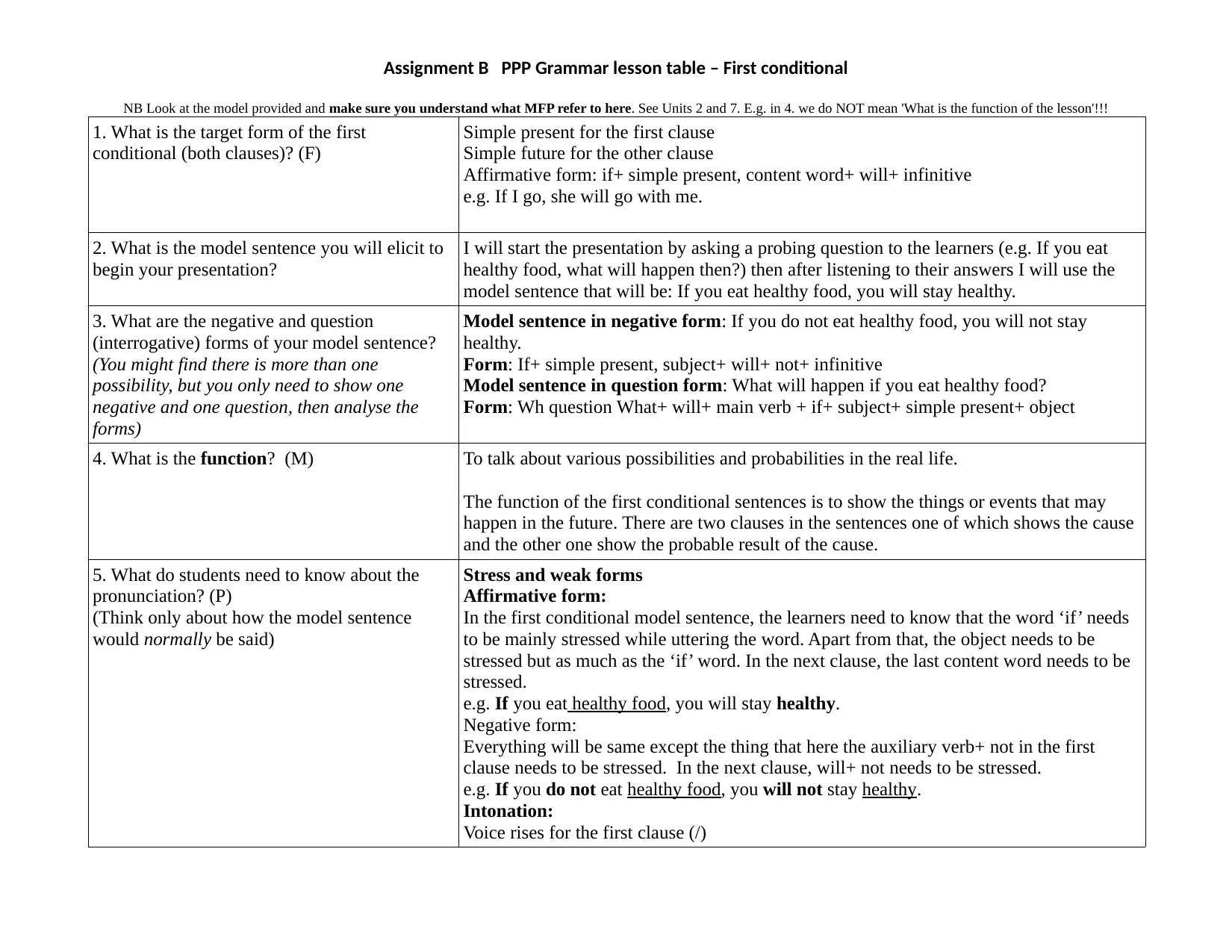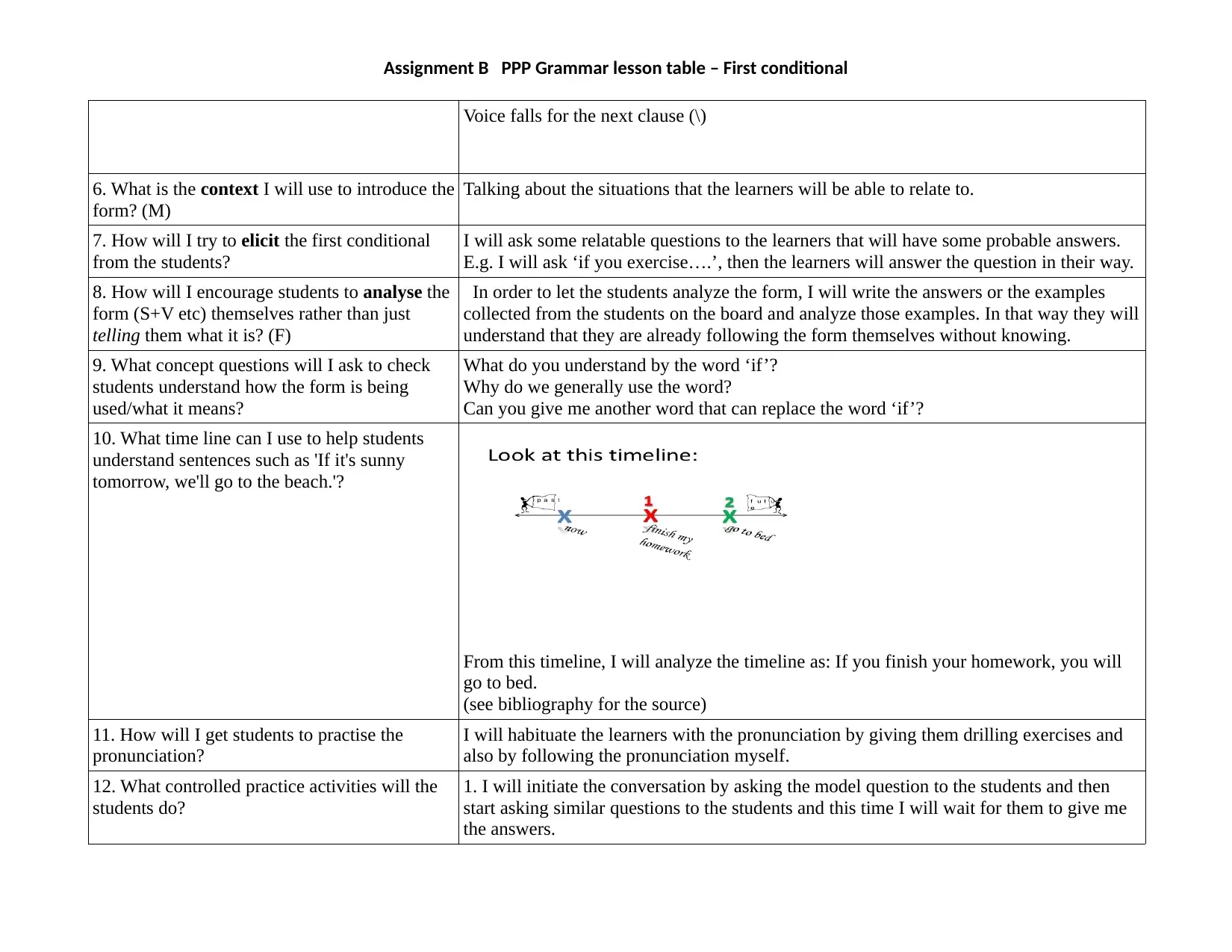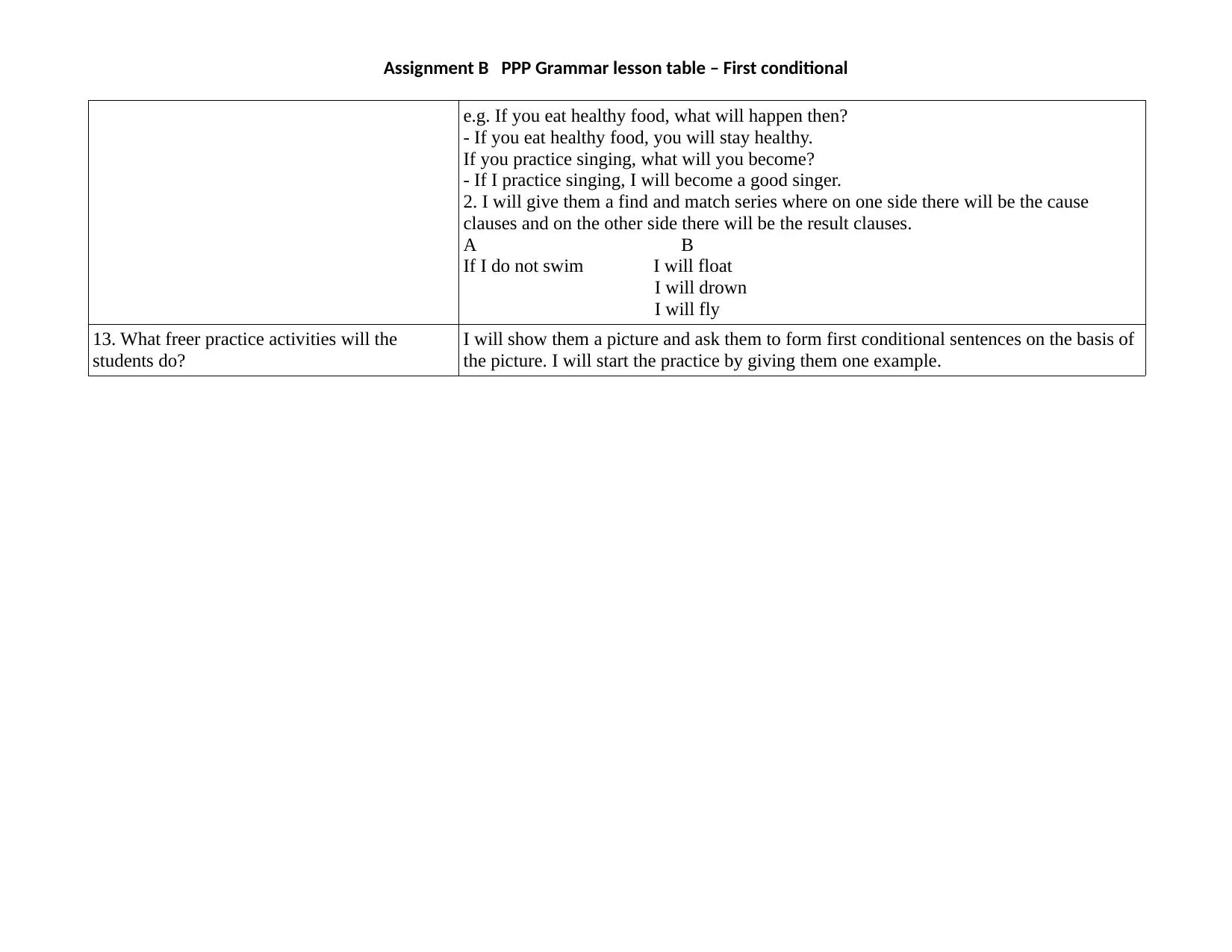Developing a First Conditional Lesson Plan for Language Learners
VerifiedAdded on 2022/11/03
|3
|1123
|326
Homework Assignment
AI Summary
This assignment presents a detailed lesson plan focused on teaching the first conditional in English to language learners. The plan covers various aspects of a grammar lesson, including the target form (affirmative, negative, and interrogative), pronunciation, function, context, and elicitation techniques. It outlines how to introduce the form, encourage student analysis, and check comprehension through concept questions. The lesson incorporates a timeline to aid understanding and includes controlled and free practice activities. The plan details board work, model sentences, and example dialogues. The assignment also includes references to teaching methodologies and resources. The overall objective is to equip teachers with a structured approach to effectively teach first conditional sentences, enhancing students' ability to use the form accurately and communicatively.

Assignment B PPP Grammar lesson table – First conditional
NB Look at the model provided and make sure you understand what MFP refer to here. See Units 2 and 7. E.g. in 4. we do NOT mean 'What is the function of the lesson'!!!
1. What is the target form of the first
conditional (both clauses)? (F)
Simple present for the first clause
Simple future for the other clause
Affirmative form: if+ simple present, content word+ will+ infinitive
e.g. If I go, she will go with me.
2. What is the model sentence you will elicit to
begin your presentation?
I will start the presentation by asking a probing question to the learners (e.g. If you eat
healthy food, what will happen then?) then after listening to their answers I will use the
model sentence that will be: If you eat healthy food, you will stay healthy.
3. What are the negative and question
(interrogative) forms of your model sentence?
(You might find there is more than one
possibility, but you only need to show one
negative and one question, then analyse the
forms)
Model sentence in negative form: If you do not eat healthy food, you will not stay
healthy.
Form: If+ simple present, subject+ will+ not+ infinitive
Model sentence in question form: What will happen if you eat healthy food?
Form: Wh question What+ will+ main verb + if+ subject+ simple present+ object
4. What is the function? (M) To talk about various possibilities and probabilities in the real life.
The function of the first conditional sentences is to show the things or events that may
happen in the future. There are two clauses in the sentences one of which shows the cause
and the other one show the probable result of the cause.
5. What do students need to know about the
pronunciation? (P)
(Think only about how the model sentence
would normally be said)
Stress and weak forms
Affirmative form:
In the first conditional model sentence, the learners need to know that the word ‘if’ needs
to be mainly stressed while uttering the word. Apart from that, the object needs to be
stressed but as much as the ‘if’ word. In the next clause, the last content word needs to be
stressed.
e.g. If you eat healthy food, you will stay healthy.
Negative form:
Everything will be same except the thing that here the auxiliary verb+ not in the first
clause needs to be stressed. In the next clause, will+ not needs to be stressed.
e.g. If you do not eat healthy food, you will not stay healthy.
Intonation:
Voice rises for the first clause (/)
NB Look at the model provided and make sure you understand what MFP refer to here. See Units 2 and 7. E.g. in 4. we do NOT mean 'What is the function of the lesson'!!!
1. What is the target form of the first
conditional (both clauses)? (F)
Simple present for the first clause
Simple future for the other clause
Affirmative form: if+ simple present, content word+ will+ infinitive
e.g. If I go, she will go with me.
2. What is the model sentence you will elicit to
begin your presentation?
I will start the presentation by asking a probing question to the learners (e.g. If you eat
healthy food, what will happen then?) then after listening to their answers I will use the
model sentence that will be: If you eat healthy food, you will stay healthy.
3. What are the negative and question
(interrogative) forms of your model sentence?
(You might find there is more than one
possibility, but you only need to show one
negative and one question, then analyse the
forms)
Model sentence in negative form: If you do not eat healthy food, you will not stay
healthy.
Form: If+ simple present, subject+ will+ not+ infinitive
Model sentence in question form: What will happen if you eat healthy food?
Form: Wh question What+ will+ main verb + if+ subject+ simple present+ object
4. What is the function? (M) To talk about various possibilities and probabilities in the real life.
The function of the first conditional sentences is to show the things or events that may
happen in the future. There are two clauses in the sentences one of which shows the cause
and the other one show the probable result of the cause.
5. What do students need to know about the
pronunciation? (P)
(Think only about how the model sentence
would normally be said)
Stress and weak forms
Affirmative form:
In the first conditional model sentence, the learners need to know that the word ‘if’ needs
to be mainly stressed while uttering the word. Apart from that, the object needs to be
stressed but as much as the ‘if’ word. In the next clause, the last content word needs to be
stressed.
e.g. If you eat healthy food, you will stay healthy.
Negative form:
Everything will be same except the thing that here the auxiliary verb+ not in the first
clause needs to be stressed. In the next clause, will+ not needs to be stressed.
e.g. If you do not eat healthy food, you will not stay healthy.
Intonation:
Voice rises for the first clause (/)
Paraphrase This Document
Need a fresh take? Get an instant paraphrase of this document with our AI Paraphraser

Assignment B PPP Grammar lesson table – First conditional
Voice falls for the next clause (\)
6. What is the context I will use to introduce the
form? (M)
Talking about the situations that the learners will be able to relate to.
7. How will I try to elicit the first conditional
from the students?
I will ask some relatable questions to the learners that will have some probable answers.
E.g. I will ask ‘if you exercise….’, then the learners will answer the question in their way.
8. How will I encourage students to analyse the
form (S+V etc) themselves rather than just
telling them what it is? (F)
In order to let the students analyze the form, I will write the answers or the examples
collected from the students on the board and analyze those examples. In that way they will
understand that they are already following the form themselves without knowing.
9. What concept questions will I ask to check
students understand how the form is being
used/what it means?
What do you understand by the word ‘if’?
Why do we generally use the word?
Can you give me another word that can replace the word ‘if’?
10. What time line can I use to help students
understand sentences such as 'If it's sunny
tomorrow, we'll go to the beach.'?
From this timeline, I will analyze the timeline as: If you finish your homework, you will
go to bed.
(see bibliography for the source)
11. How will I get students to practise the
pronunciation?
I will habituate the learners with the pronunciation by giving them drilling exercises and
also by following the pronunciation myself.
12. What controlled practice activities will the
students do?
1. I will initiate the conversation by asking the model question to the students and then
start asking similar questions to the students and this time I will wait for them to give me
the answers.
Voice falls for the next clause (\)
6. What is the context I will use to introduce the
form? (M)
Talking about the situations that the learners will be able to relate to.
7. How will I try to elicit the first conditional
from the students?
I will ask some relatable questions to the learners that will have some probable answers.
E.g. I will ask ‘if you exercise….’, then the learners will answer the question in their way.
8. How will I encourage students to analyse the
form (S+V etc) themselves rather than just
telling them what it is? (F)
In order to let the students analyze the form, I will write the answers or the examples
collected from the students on the board and analyze those examples. In that way they will
understand that they are already following the form themselves without knowing.
9. What concept questions will I ask to check
students understand how the form is being
used/what it means?
What do you understand by the word ‘if’?
Why do we generally use the word?
Can you give me another word that can replace the word ‘if’?
10. What time line can I use to help students
understand sentences such as 'If it's sunny
tomorrow, we'll go to the beach.'?
From this timeline, I will analyze the timeline as: If you finish your homework, you will
go to bed.
(see bibliography for the source)
11. How will I get students to practise the
pronunciation?
I will habituate the learners with the pronunciation by giving them drilling exercises and
also by following the pronunciation myself.
12. What controlled practice activities will the
students do?
1. I will initiate the conversation by asking the model question to the students and then
start asking similar questions to the students and this time I will wait for them to give me
the answers.

Assignment B PPP Grammar lesson table – First conditional
e.g. If you eat healthy food, what will happen then?
- If you eat healthy food, you will stay healthy.
If you practice singing, what will you become?
- If I practice singing, I will become a good singer.
2. I will give them a find and match series where on one side there will be the cause
clauses and on the other side there will be the result clauses.
A B
If I do not swim I will float
I will drown
I will fly
13. What freer practice activities will the
students do?
I will show them a picture and ask them to form first conditional sentences on the basis of
the picture. I will start the practice by giving them one example.
e.g. If you eat healthy food, what will happen then?
- If you eat healthy food, you will stay healthy.
If you practice singing, what will you become?
- If I practice singing, I will become a good singer.
2. I will give them a find and match series where on one side there will be the cause
clauses and on the other side there will be the result clauses.
A B
If I do not swim I will float
I will drown
I will fly
13. What freer practice activities will the
students do?
I will show them a picture and ask them to form first conditional sentences on the basis of
the picture. I will start the practice by giving them one example.
⊘ This is a preview!⊘
Do you want full access?
Subscribe today to unlock all pages.

Trusted by 1+ million students worldwide
1 out of 3
Related Documents
Your All-in-One AI-Powered Toolkit for Academic Success.
+13062052269
info@desklib.com
Available 24*7 on WhatsApp / Email
![[object Object]](/_next/static/media/star-bottom.7253800d.svg)
Unlock your academic potential
Copyright © 2020–2025 A2Z Services. All Rights Reserved. Developed and managed by ZUCOL.





